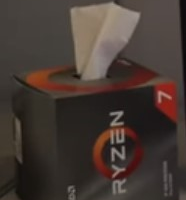-
Posts
134 -
Joined
-
Last visited
Awards
This user doesn't have any awards
Recent Profile Visitors
1,081 profile views
dbx10's Achievements
-
Film your unboxing with your phone, STH was recently sent an open box 3070 when he ordered a BNIB 3090. They should swap it if anything is wrong with your order, but you're always better off taking precautions.
-
It's more than enough for most NAS uses. If you don't know whether or not you need more PCIe lanes, you probably don't.
-
This is not actually an argument against ZFS, because that's inconsequential to other programs you might be running. ZFS uses all available RAM for caching but dynamically frees any amount you need for other programs. It's designed that way, and your memory is never actually locked to the filesystem. Hardware RAID is one memory chip or ROM failure away from an entire array becoming corrupt and inaccessible. Modern filesystems don't implicitly trust the hardware they run on, because hardware fails. Checksums don't lie, and that's why copy-on-write filesystems are inherently better. If this was a conversation about movies, then we haven't watched the same movie you and I.
-
https://en.wikipedia.org/wiki/RAID In this case, the RAID card is a hardware RAID configuration and it manages groups of drives on its end and presents them as a single or multiple virtual drives to Windows depending on how many arrays are created. I honestly wouldn't bother with it unless you wanna learn, but hardware RAID is all but dead in the server space. I'd flash the firmware on the card to IT mode, so it passes the drives through to the OS. There's plenty of guides online on how to flash IT mode on PERC cards, and there's no conceivable way to brick a raid card by trying to flash it. The card has its own write protected boot loader. EDIT: if you already have files on the drives, don't create an array. Doing so will destroy your data. If you flash the raid card into IT mode, you will be able to access your drives as is.
-
Many points: Hardware RAID is dead in the enterprise space, and for very good reasons. Even multiple thousand dollar RAID cards fail, and sometimes introduce data corruption into your array, which it is oblivious to. RAID was fine in the 1990s and early 2000s, when it was all we had. OpenZFS and hopefully soon BTRFS offer better availability and redundancy out of the box. Your ZFS pool remains accessible in case of a drive failure, and the software regulates data integrity. ZFS doesn't trust a drive as far as it can throw it. Windows server is only reliable within their ecosystem of services and validated partners. It CAN work, but there's also a reason why the use of Windows is at an all time low in the server space. It's just not as reliable or as flexible, and certainly not as stable. TrueNAS Core's "stable" release train goes through 8 rounds of validation before releasing, it's enterprise grade and rock solid. As for the plugins and the apps, virtualize them if you're not comfortable with BSD's jail system. I'm currently running an Ubuntu server box on bhyve just for my docker containers. Sure, you can still run a RAID card and an obsolete redundant array, but ultimately there is no cost to running more modern and proven solutions. So why not? Proxmox, TrueNAS Core, ZFS on the Linux distro of your choice, you can even distro hop and move your ZFS pool every time, should you want to. I'd also like to know specifically what you mean by "unpolished". Genuinely asking, it's not a snarky rhetorical question.
-
Nextcloud plugin can achieve this but it's not really what you're looking for, and making it secure is an endeavor in and of itself. I'd opt for a VPN and scheduled rsync tasks on employee computers, if they're properly controlled by your company domain this should be a single extra GPO or scheduled task.
- 4 replies
-
- truenas
- truenas scale
-
(and 3 more)
Tagged with:
-
Short answer is no. Long answer is hell no.
-
TrueNAS really isn't that hard, just whip up a Linux server VM and run whatever doesn't run as a plugin there. EDIT: Scale is not ready for prod yet, I'd stick with Core and virtualize anything you need on Linux, especially if you wanna run Docker. EDIT 2 electric boogaloo: Windows server is hot garbage and you will lose data and your mind using it.
-
This very likely is coincidental, humidity should have nothing to do with high frequency AC current going through passive electronic components and vibrating them audibly. It's common for it to come and go, in my experience.
-
2nd gen ryzen is enough for me and my emby server streams to sometimes up to 3 clients at once. I don't even have hardware acceleration either, it's just the CPU chugging along fine. Anything recent with integrated graphics will be more than enough to transcode and stream 1080p movies to two clients at once. If you don't care about losing the data on it then a full blown NAS is not really necessary.
-

NAS Build - Hardware and Software Help
dbx10 replied to DingdongTP's topic in Servers, NAS, and Home Lab
If I recall correctly Squarespace retains control of everything regarding your domain name, I'd check with support. I use NC as a google drive replacement, as it's easy to share files to people online via webdav. What makes it secure is reverse proxying the access to it via cloudflare's SSL. OpenVPN is a good solution too, but you still need a way to present the files you want to share to individual customers. NC has account management and access settings per account already built in. You can disable all the plugins you don't need like calendar, contacts, and all the "office" stuff -

Automatic Backup to Network Path?
dbx10 replied to Ginger Penguin's topic in Servers, NAS, and Home Lab
You can setup a scheduled task on startup to mount an iscsi target, SMB or NFS share as a network drive, and you can set that as your target for automatic backups.











